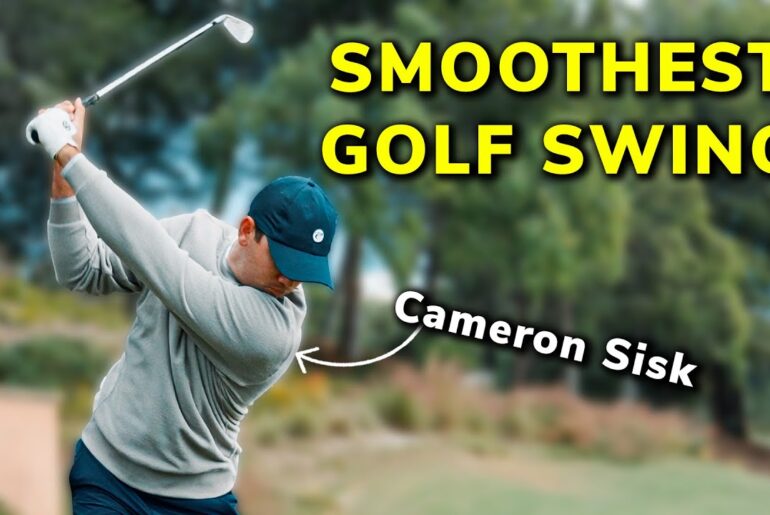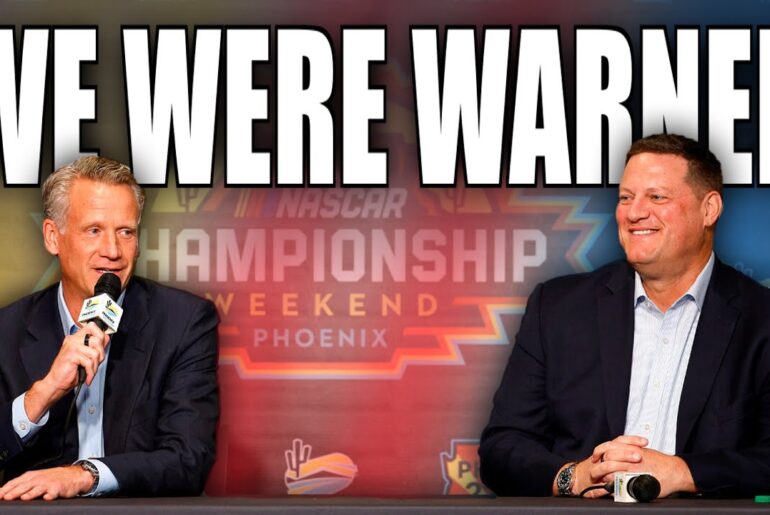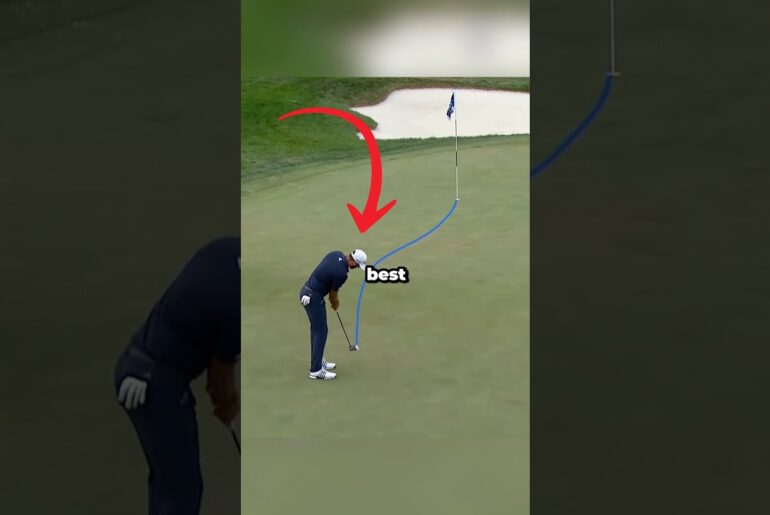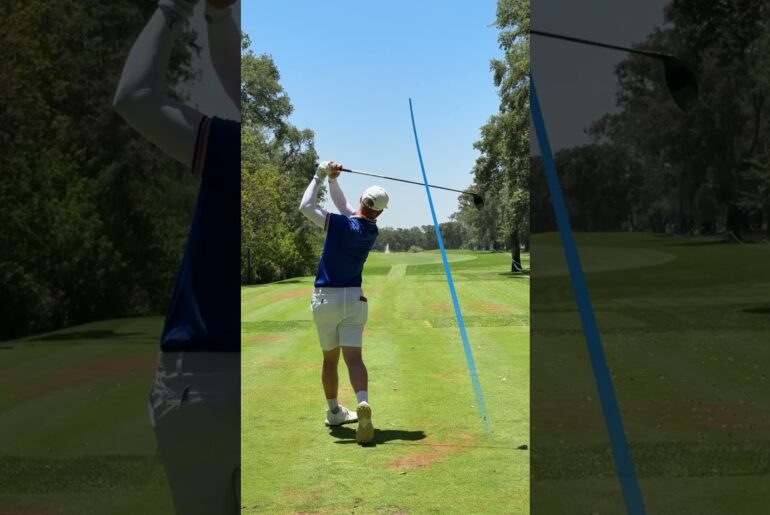Padraig Harrington shares his thoughts on the keys to being a great putter and the ones that helped him with three major championships. Padraig talks setup, grip, path, stroke, reading the greens, drills and other tips that will instantly help all golfers putt better.
Welcome to Golf Channel Academy. I’m your host, Martin Hall. We’re here at the Grand Cypress Club in Orlando, Florida, and I’m delighted to be joined by three-time major champion Podrick Harrington. Obviously, we’re on the green. This is your putting special. Tell us what you think people should be doing to putt better. Podrick. Yeah, this is a little bit of do as I say, not as I do. So, if I was teaching somebody, first of all, I get them to get a nice wide stance. That gives stability here. Then I’d like to see them put both hands facing each other. Now I like to go left hand below right. And I would teach somebody this purely because it brings the left shoulder forward. So if anything, you’re going to get a slightly inside stroke. Sometimes if the left hand is high, your shoulders get open. It could cause you to cut across it, which isn’t great for getting the ball to spin down into the hole. Okay. So slightly wide stance. Ball position always about an inch, inch and a half ahead of your sternum to the left hand side. This encourages underneath your sternum will be the lowest point of the stroke. After that, the putter’s rising a bit. Again, helping to give a little bit of top spin on the ball. Okay. So, once we’re in position, hands facing each other, I’m basically looking at a smooth stroke, not a very slow stroke, a smooth backstroke, and a slightly longer follow through. I want to hold the finish. Okay? Always very important. Smooth stroke, slightly longer follow through. Again, we’re not taking a slow stroke and pushing. We’re more looking like I like to think of it if I had my right hand and I was rolling the ball into the hole. This is how I control pace. So, I’m never trying to hit a putt. I’m always just taking a little longer a stroke in order to make the ball go further. Again, hands slightly forward. This putter doesn’t have enough loft for this, but in general, your hands slightly forward. eyes over the ball. And here’s one change I make. I think compared to a lot of players, I like to teach to watch the ball. Now, in modern teaching, or for years, people would say, “Keep your head still. Keep your head still.” I actually teach, and I think this is a great thing. If you can, it can become a habit. Watch the ball with your eyes. That means your head won’t move. So, as that ball is traveling out the first couple of feet, my eyes are tracking it. No need to move my head. that I can see it. It tracks it for four or five feet with my eyes and then my head will move up. If I can make that a discipline, there’ll be less chance that I’ll move anxiously to see where it’s going because it is absolutely natural for any human being to watch the ball as it’s going to the target. That’s normal. So, why not teach yourself to do it properly rather than spend your whole life, which a lot of guys like me trying not to look up or we’re trying to stay nice and still. It works, but it’s not natural. So for a young guy, person coming to the game, I would teach them to watch the ball running here in the first couple of feet of the putt with their eyes and then their head will move up rather than when you see a bad foot, the head moves first. And actually, they don’t even see the ball running for the first couple of feet. Well, yeah, I was going to come to that. Obviously, that is important to you. Can I ask why that’s so important? cuz some would say the ball has gone. What difference does it make? If you can get to this position where you’re balanced and held your finish to get there, you’ve done so many things right in terms of accelerating at a nice pace through the putt. People, a lot of people who struggle with puts, they have this rebound effect and that’s actually a deceleration and then you’re coming back. By holding the finish, it should help to ensure a constant momentum through the putt. It’s not a huge acceleration. There’s a nice rhythmical back swing and a nice acceleration through. It’s certainly nothing fast and jerky, but again, it’s not slow either. Slow is not a good thing in in any part of the game. It’s smooth, but it’s the same as as a right-handed person, you’d roll the ball at that pace. So, that’s the rhythm on my putting stroke. I put the putter down, good, solid base because I want to keep this stable. I want to keep my body stable. I want to keep my head stable. The only thing moving here is my shoulders and my arms. My hands are neutral against each other slightly forward. Line up and watch the ball. Just like that. Maybe I should do that more in tour. A terrific foundation to get us going in your putting special. Now, when we come back, Potter’s got some drills to talk to us about, and you’re going to enjoy those. I promise you. I’ve got an eightfooter to win the Barcley Classic 2004. Downhill very fast for the win. I still to this day, I don’t know, it’s gone across like a cellophane bridge right across the right lift. At that pace, I still don’t know how it didn’t drop. It only got an inch by the hole. So the following year I’ve come back I’ve had this 66 ft push and it’s broken right to left then it’s come up over the hill left to right and it’s got right on top of the hill with 8 ft to go it’s right smack in the middle on the exact same line as I’ve had to put the year before. So as it’s tracking down there I’m looking don’t break don’t break don’t break don’t break don’t break and literally the last 8 ft felt like it took about 20 seconds. Oh yes, Harrington. A remarkable eagle to finish and win the 2005 Barkclays Classic. [Music] Well, that’s another one. You don’t win 30 tournaments around the world without holding putts. And you don’t hold putts without doing drills. Haven’t seen this one. Talk me through it, please. Yeah, look, as players, we all like doing drills. And if you go to a tour event, you’ll see a lot of guys doing drills. Again, the idea of a drill is you’re trying to work on something technical, but not consciously. So, you’re doing it, you’re getting the technical side covered, but your subconscious is also working rather than your conscious getting involved. Okay. So, what am I really doing here? This elastic band, there’s no tension behind the ball. So, it’s nice and loose. I take it back, still loose, but from impact and forward, there’s tension from the band, which helps me accelerate gently and hold my finish. So again, line up and it helps me hold my finish like so. And I might exaggerate it and hold it for a couple of seconds. You can do this, obviously, you can’t do this on the golf course in tournament play. That would be against the rules to use any training aid. Can’t take any training aid out your bag on the golf course. You got to leave it in there. Can’t use it. But you can do the same thing by just pressing your putter into your into your foot like so. And once you take it away, the putter head will want to accelerate forward and stay in that position and it stops that kind of rebound effect. I I think it’d be interesting for viewers to know, Podrick, is this the sort of thing a player like you might do in the hotel room in the evening? Oh, yeah. Absolutely. I what I tend to do at home is I have that have an elastic band around the leg of a of a chair in my in my golf room. a putter, a spare putter on it. So, every time I walk by it, I might hit five, 10 putts, 15 putts. In between hitting shots, I’ll go and hit a few putts. So, it’s not something you do for hours on end. It’s something you just keep going back to for, as I said, for a minute or two every so often. Okay. So, rubber band one drill. Uh line on the ball. Is that a drill you would use? Absolutely. Oh, I only use it on the putting green, which is I was brought up on big sloping greens and I’m all about the feel of putts, but if I was a young kid, I definitely start off using a line on every putt. I just can’t get used to it. I’m I’m trying to line this one up here and I’m like changing it so many times. But I do use the line when I’m practicing just to check my own alignment. So, I’ve lined up there. Got it pretty good. Easy this time. So using the line to line up, that’s something perhaps all golfers should do a little bit on. I think everybody should do a little bit on the putting green. Alignment is a massive part. It’s not end all and be all of good putting. The most important thing with putting is the ball starts where you think you’re lined up, but it does help if you’re lined up there in the first place. So yes, practice with a line and lining up. two other drills I do every week in tournaments h as practice I actually practice with my eyes closed or I practice looking at the hole. So you see Jordan doing this Jordan Speed does it in tournament play which is fair play to him. It takes a lot of guts to look at the hole. H it takes a lot of guts to put your eyes closed. I believe I think BJ Singh done it when he was winning when he won the Masters. He kept his eyes closed. So essentially, if you keep your eyes closed, you line up in there, eyes closed. Now, what happens is I’m not seeing my backstroke. And if you don’t see the putter in the backstroke, you don’t then try and control it. And that would be the same if I looked at the hole. So if I line up, look at the hole. Okay, I can’t see my backstroke. Now that stops me controlling it. And that’s the one thing you don’t want to do when you’re on the golf course. And and it’s something you see an amateur do a lot. You know, they try and get slow here. And the minute you’re looking at that pter head, you’re going to start controlling what it’s doing. And and anything can happen when you’re putting at your best, you look at the target, you line up, you look at your target, and as you’re putting, you’re really not seeing the putter head. It’s a blur down there. You’re certainly I actually should do that more often. It certainly becomes unconscious. There’s no conscious control of the porter head. As I said, I could not actually tell where my club face was there. It it I could see that there was some movement, but I couldn’t see the detail. And that’s a nice place to be at. And you will get that feeling with your eyes closed. You’ll get that feeling looking at the hole. Well, I think as your friend and mentor Dr. Bob Ratella said, the great paradox of golf is you can only get control of the ball when you give up control of the swing. Yes. I wish it was easy as it is said. Yeah, that’s for sure. Listen, four terrific drills there that pretty much anybody who wants to put better, yes, that’s you. Anybody who wants to put better, you should try these four drills. Now, it’s not just about drills. It’s not just about the stroke. When we come back, three-time major champion Podrick Harrington wants to talk about reading green. Something I think you’re rather good at. It’s going to be great. That is unusual for a left hand low putter. Yes. To be left hand low but have no loft on your putter. That is unusual. And then I crank it back because I use the face to line up rather than the back of the putter. There’s no lines on my putter. Every line I’ve ever put in a putter looks like a Damon to the right. Back on the putting green is Patty’s putting special. Obviously, we’ve moved a little further away from the hole. And just for television, we’ve left the flag stick in the hole. We know you couldn’t do that. That’s just to make it easier for the players at home to see. Uh reading greens. It’s really important, isn’t it? Good putting starts with good re green reading. I have to say when I see somebody who’s a chronically bad putter, you know, to the extent that they close to having the yips, it’s all started from the underbaring. So if you underbarrow, it requires a huge amount of manipulation to get it online. If you overbarrow, and bear in mind that amateurs tend to underread the greens by a factor of three compared to pros. If you overbarrow, you’re going to hit a good putt, a good stroke. Yes, you may miss a few puts high, but it’s certainly better for your confidence and better for your stroke. So, if anything, always give it a little bit more break. But how do we actually get the exact read? First and foremost, easiest thing when it comes to reading the greens, it’s the color. So, as I stand here, I’m looking at this put. The first sort of 15 ft, it’s dark green. Anything that’s lush and dark green is going to be slow and uphill. At the top of the hill there, it kind of mixes the color. So, we’re going to suggest that’s kind of flat where it’s mixing. And then we see this pale color for the last 20 ft. Again, in life, anything that’s shiny is fast. It’s slippery. So, I know I’m going uphill, levels out, and then downhill. Now, if I walk around, those colors will change. And I’ll know if it’s if I turn to the right here and I look back up, if I see it’s dark, that means it’s uphill. So, it’ be left to right coming across here. So, your colors, use your colors. So once you’ve identified the colors, the dark and the light, what comes next? Golf ball’s on the ground. I walk up. I’m seeing the colors naturally myself. I I don’t even have to work at it. I mark it to save time. As I mark it, I’ll just walk up straight behind it. Put the pter down. Careful not to hit the coin because you can’t touch the coin. Okay, that feels about 20 in left. When it’s my turn to play, I’ll put the ball down. I don’t really need to look from the other side. Walk back. I’m trying to see my 20 ines. I might add a little. I might take a little away, but general I’m going to stick to more or less what I felt. Come back. I have a couple of practice strokes. Obviously, again, the key here is my practice strokes are very realistic. I’m not taking this. I’m hitting a 35 foot P here. I’m not going like this to hit it. I’m actually taking that will get me to the hole. Little bit slow up the hill. Yeah, that feels good. That feels good. When I put the putter down, this is the key to holding putts. I’m never standing over this ball saying I’ve got to be up. And I’m never standing over this ball saying if it was a downhiller, oh, don’t hit it by. I’ve already dialed that in here. That’s all covered in my And I don’t wish it washed through. I actually take real practice strokes. That’s covered. No more conscious thought. Look at my target. Well, you’d be very happy with that for the most very comfortable with that stone dead. But there is one thing and it’s for short puts. So every time you and it’s particularly evident down here in Florida, but you’ll see that nearly on all golf courses you gain experience. So now I’ve put it up here. Say I’ve got a three-footer. All three-footers are not straight. Okay. Unfortunately, that’s what amateurs tend to think I can hit it firm and straight, but ultimately if there’s a break, there’s a break. Now, what you’ll see on a cup is every cup, especially in Florida, a little bit when you get up north more sunshine, the low side of the cup starts to fray by the end of the day. It actually frays pretty early on. And as you can see here, if you can see, it’s all starting to break down here. It will turn brown. It will be burnt out by the end of the day. I know that’s where the biggest bit of wear and tear is. So, that’s the lowest point. So everything is breaking to that point there. Right down there. So essentially without me bending down here, if that’s the low point, I know I need I’ve got to aim a little bit to the left. So instead of trying to blast it in straight, I’m going to hit it left half. And again, if I aim straight, yes, I could knock it in from there, but sometimes it requires a bit of manipulation. And that’s where all this sort of heebie-jebies come from. That is going to help a lot of people read greens, a subject they find very difficult. And when we come back, we’re going to talk about some of the unique aspects of Podrick’s own putting stroke. Very interesting. We’re back. One final segment here. Podrick Harrington, your putting stroke. And you call them peculiarities. I don’t think they’re peculiar. They’re just your way. Tell us about that. Yeah, look, I grew up in a very competitive golf club. We hustled all the time. I friends we played with. We always played for money, played for a golf ball, a drink or whatever. And ultimately, every match comes down to can you get these putts in the hole every day. And if you couldn’t, you had to leave. There’s no point in you playing. So some of putting, yeah, you want to have a nice putting stroke and you want to do everything right. But ultimately, you want to hit the ball where you’re where you think you’re aiming. And when you start practicing just trying to get the golf ball in the hole, I have found for me, this won’t apply to everybody because of my eyesight, you’ll see there’s no lines on the back of my putter because if I look at a line here, it looks like it’s aiming right. You will also see I have no loft on my putter, but I actually crank my hands back, which wouldn’t be a good thing to teach, but that’s because I’m using the face to line up. So, I’m lining up the whole face to where I’m going. Now, that seems square to me. Whereas I would teach this. This is what looks good to me. The putter head is sitting back again. Very much concentrating on my routine. Can I get this routine? Ultimately, I love my routine to be one 2 3 4 5 6 7 8 9. So, if I could hit the putt, every putt like that in a tournament, and as I said, the putt I hold on the fourth playoff hole, the winning putt at Carnusi in 2007, I definitely could have. If you go to that camera, you can see me go 1 2 3 4 5 6 7 8 9. The metadome effect of putting the routine of continuous sequence. There’s no stopping. There’s no time in that putt to allow conscious thought creep in. Am I lined up properly? So, we go one, two, three, four, five, 6, 7, 8, 9. Okay, we don’t want to get involved. Okay, I’m left hand below right I grew up, nobody put it left hand below right when I was grow up. I grew up like this. But the day I turned pro, first day of tour school, I was cutting my putts. I couldn’t hold a left or right putt. So what do you do if you can’t hold the putt? You find a way to get it in the hole. That’s the most important thing. Can I get it in the hole? And I found if I put my left hand below right, I had a tendency to pull it down the line on a left to right put, which isn’t a bad thing. So the putt was starting up on the high side. I was holding more putt. For my first two years on tour, I put it my left to right putts this way and I put it my right to left puts conventional. Now, another thing I do on my putts, again, I don’t like the putter rotating through impact at all. I I hate a pull. I think a lot of players hate that release pull. So, you’ll see I actually crank my left hand and I have cranked it that far over in order to hold that wrist down. You can see that wrist is locked. So, so this would be a very good way if people tend to pull their putts to the left. This would be sort of really good medicine to take. Oh, absolutely. This this is is I’m playing a hold off cut here. You might get a little bit of cut spin, but hey, it works for me. You know, for the next guy, yeah, if you’re releasing it too much, do try and just wrap that hand underneath. Put the thumb basically at 90° to the putter. Just like so. I think I’ll be I think I’ll be doing more of that next week, actually. Absolutely terrific. Listen, that’s been absolutely wonderful.








1 Comment
I love watching Paddy’s golf videos. Using common sense, with easy to understand tips and drills, and without a lot of technical jargon, he is very relatable.